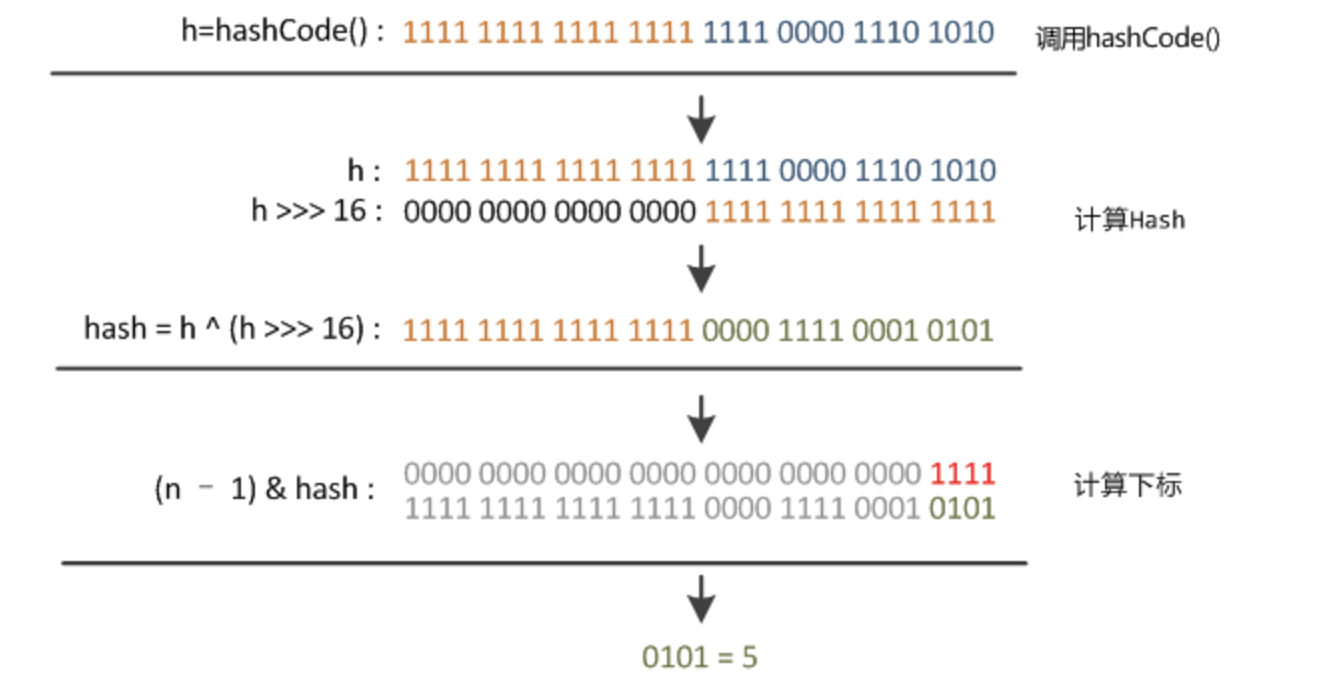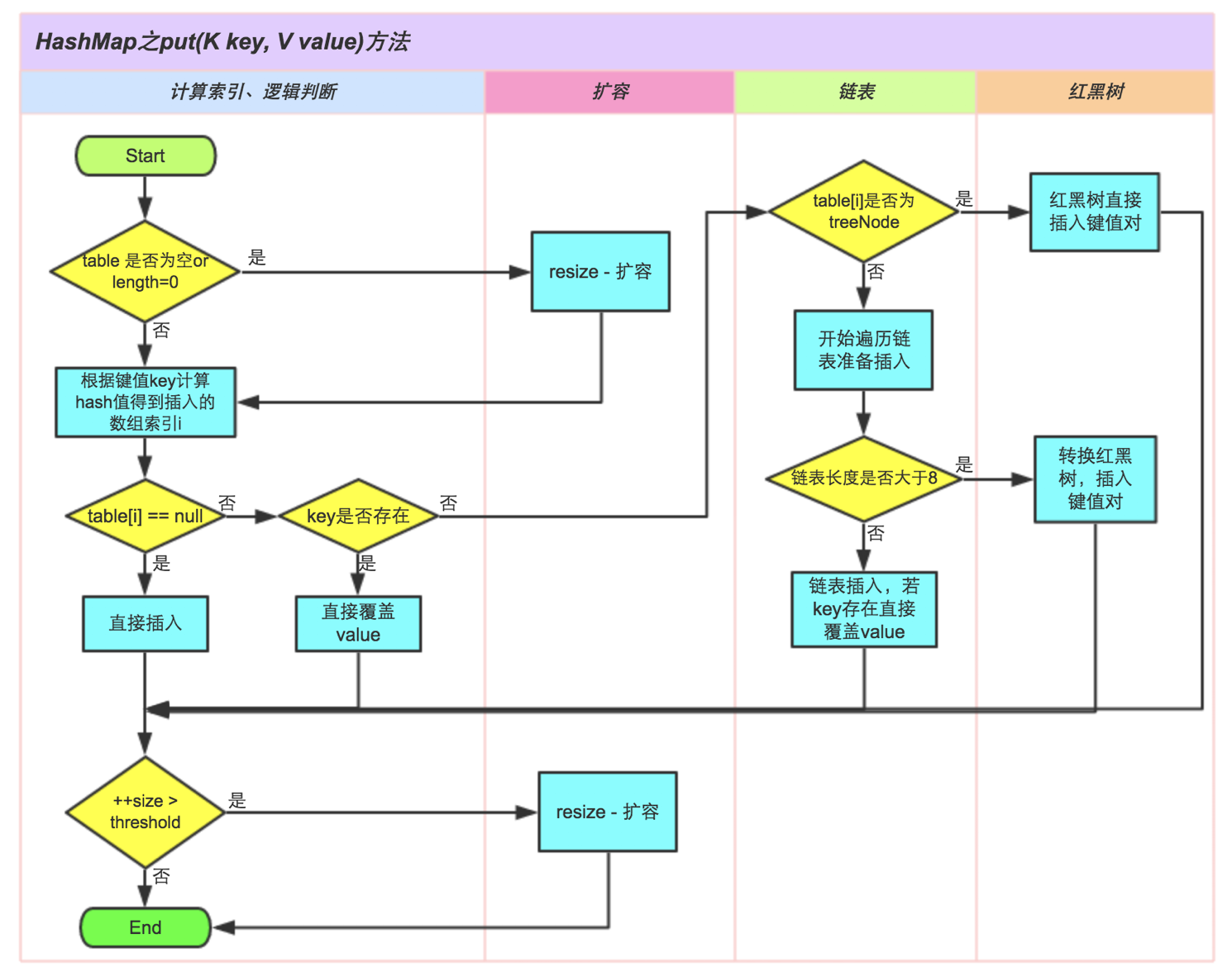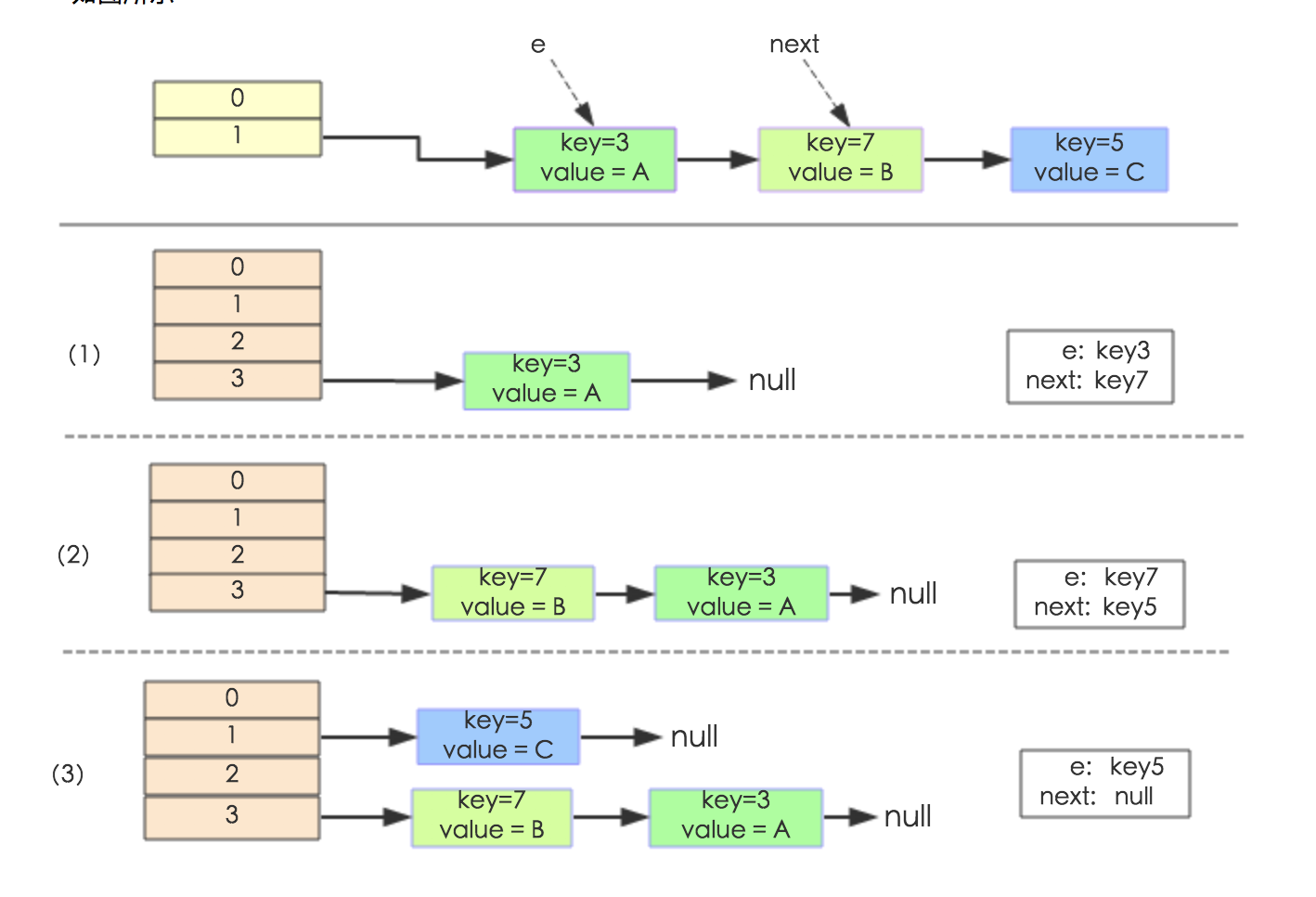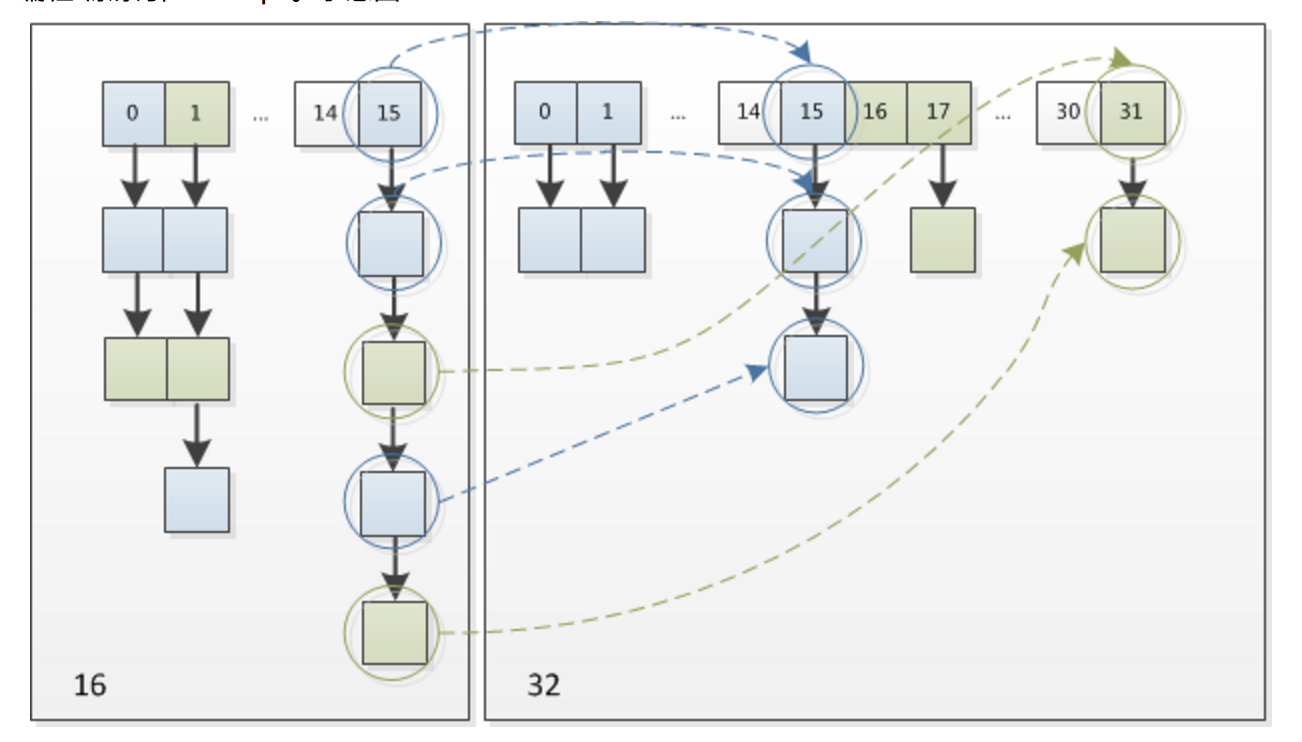存储接口-字段
HashMap的数据结构是数组+链表+红黑树(JDK1.8增加了红黑树部分)实现的,如下图所示:

HashMap类有一个非常重要的字段Node[] table,即哈希桶数组,是一个Node数组
/**
* The table, initialized on first use, and resized as
* necessary. When allocated, length is always a power of two.
* (We also tolerate length zero in some operations to allow
* bootstrapping mechanics that are currently not needed.)
*/
transient Node<K,V>[] table;
首先来看一下Node类:
/**
* Basic hash bin node, used for most entries. (See below for
* TreeNode subclass, and in LinkedHashMap for its Entry subclass.)
*/
static class Node<K,V> implements Map.Entry<K,V> {
final int hash;
final K key;
V value;
Node<K,V> next;
Node(int hash, K key, V value, Node<K,V> next) {
this.hash = hash;
this.key = key;
this.value = value;
this.next = next;
}
public final K getKey() { return key; }
public final V getValue() { return value; }
public final String toString() { return key + "=" + value; }
public final int hashCode() {
return Objects.hashCode(key) ^ Objects.hashCode(value);
}
public final V setValue(V newValue) {
V oldValue = value;
value = newValue;
return oldValue;
}
public final boolean equals(Object o) {
if (o == this)
return true;
if (o instanceof Map.Entry) {
Map.Entry<?,?> e = (Map.Entry<?,?>)o;
if (Objects.equals(key, e.getKey()) &&
Objects.equals(value, e.getValue()))
return true;
}
return false;
}
}
哈希表为解决冲突,可以采用开放地址法和链地址法等来解决问题,Java中HashMap采用了链地址法。简单来说,就是数组加链表的结合。在每个数组元素上加一个链表结构,当数据被Hash后,得到数组下标,把数据放在对应下标元素的链表上。
map.put(“Mjx”,”Master");
系统将“Mjx”这个key的hashCode()方法得到其hashCode值,然后通过hash算法来定位该键值对的存储位置,有时两个key会定位到相同位置,表示发生了Hash碰撞,当然Hash算法计算结果越分散均匀,Hash碰撞的概率就越小,map存取效率就越高
好的Hash算法和扩容机制能够控制map使得Hash碰撞的概率小,而且数组占用空间也少。
int threshold;
首先,Node[]table 数组的初始化长度length(默认为16),loadFactor为负载因子(默认为0.75)。threshold是HashMap所能容纳的最大数据量的Node(键值对)个数。正常情况下threshold=length * load factor。如果说构造对象的时候传入了capacity,那么threshold等于超过这个数的最小2的n次方的数。
final float loadFactor;
默认的负载因子0.75是对空间和事件效率的一个平衡选择,建议不要修改,除非在时间和空间比较特殊的情况下,如果内存空间很多而对事件效率要求很高,可以降低负载因子load factor的值;相反,如果内存空间紧张而对事件效率要求不高,可以增加负载因子load factor的值,这个值可以大于1。
int modCount;
modCount字段用来记录HashMap内部结构发生变化的次数。内部结构发生变化指的是结构发生变化,例如put新键值对,但是某个key对应的value值被覆盖不属于结构变化。以下不算。
map.put(1,2);
map.put(1,3);
int size;
HashMap中实际存在的键值对数量。put多少个,size就多少。注意区分size,threshold,length的区别。不要混淆。
这里存在一个问题,即使负载因子和Hash算法设计的在合理,也免不了出现拉链过长的情况,一旦出现拉链过长,则会严重影响HashMap的性能。于是JDK1.8中,当链表长度太长(默认超过8)时,链表就转换为红黑树,利用红黑树快速增删改查的特点提高HashMap性能。
红黑树链接:
功能实现-方法
主要分析根据key获取哈希桶数组索引位置、put方法的详细执行、扩容过程三个具有代表性的点深入展开讲解。
1.确定哈希桶数组索引位置
我们当然希望这个HashMap里面的元素位置尽量分布均匀,尽量使得每个位置上的元素数量只有一个,那么当我们用hash算法求得这个位置的时候,马上就可以知道对应位置就是我们要的,不用遍历链表,大大优化了查询的效率。
HashMap中的hash算法,确定数组位置:
static final int hash(Object key) {
int h;
return (key == null) ? 0 : (h = key.hashCode()) ^ (h >>> 16);
}
第一步:h=key.hashCode(),获取hashCode值
第二步:h^h(h>>>16),高位参与运算
第三步:用数组长度-1对hash值进行取模运算
本质上就是三步:取key的hashCode值,高位运算,取模运算
下面举例说明下,n为table的长度。

2.分析HashMap的put方法
首先put的方法执行过程可以通过下图来理解:

/**
* Implements Map.put and related methods
*
* @param hash hash for key
* @param key the key
* @param value the value to put
* @param onlyIfAbsent if true, don't change existing value
* @param evict if false, the table is in creation mode.
* @return previous value, or null if none
*/
final V putVal(int hash, K key, V value, boolean onlyIfAbsent,
boolean evict) {
Node<K,V>[] tab; Node<K,V> p; int n, i;
if ((tab = table) == null || (n = tab.length) == 0)
n = (tab = resize()).length;
if ((p = tab[i = (n - 1) & hash]) == null)
tab[i] = newNode(hash, key, value, null);
else {
Node<K,V> e; K k;
if (p.hash == hash &&
((k = p.key) == key || (key != null && key.equals(k))))
e = p;
else if (p instanceof TreeNode)
e = ((TreeNode<K,V>)p).putTreeVal(this, tab, hash, key, value);
else {
for (int binCount = 0; ; ++binCount) {
if ((e = p.next) == null) {
p.next = newNode(hash, key, value, null);
if (binCount >= TREEIFY_THRESHOLD - 1) // -1 for 1st
treeifyBin(tab, hash);
break;
}
if (e.hash == hash &&
((k = e.key) == key || (key != null && key.equals(k))))
break;
p = e;
}
}
if (e != null) { // existing mapping for key
V oldValue = e.value;
if (!onlyIfAbsent || oldValue == null)
e.value = value;
afterNodeAccess(e);
return oldValue;
}
}
++modCount;
if (++size > threshold)
resize();
afterNodeInsertion(evict);
return null;
}
1.判断键值对数组table[i]是否为空或null,否则执行resize()进行扩容;
2.根据键值key计算hash值得到插入的数组索引i,如果table[i]==null,直接新建节点添加,转向6。如果不为空转到3;
3.判断table[I]的首个元素是否和key一样,如果相同则直接覆盖value,否则转向4,这里相同指的是hashCode以及equals;
4.判断table[I]是否为treeNode,即table[I]是否是红黑树,如果是红黑树,则直接在树种插入键值对,否则转向5;
5.遍历table[I],判断链表长度是否大于8,大于8的话把链表转换为红黑树,在红黑树中执行插入操作,否则进行链表的插入操作;遍历过程中发现key已经存在直接覆盖value即可;
6.插入成功后,判断实际存在的键值对数量size是否超过了最大容量threshold,如果超过,进行扩容。
扩容机制
扩容就是重新计算容量,Java里的数组是无法自动扩容的,需要使用一个新的数组代替已有的容量小的数组,就想我们用一个下桶装水,如果想装更多的谁,就得换大桶。
JDK1.7的做法:newTable[I]的引用赋给了e.next,也就是使用了单链表的头插入方式,同一位置上新元素总会被放在链表的头部位置;这样先放在一个索引上的元素最终会被放到Entry链的尾部(如果发生了hash冲突的话)
如图所示:

JDK1.8的优化:我们使用的是2次幂的扩展,所以元素的位置要么是在原位置,要么是在原位置再移动2次幂的位置。看下图。图(a)表示扩容前的key1和key2两种key确定索引位置的示例,图(b)表示扩容后key1和key2两种key确定索引位置的示例,其中hash1是key1对应的哈希与高位运算结果。

元素在重新计算hash之后,因为n变为2倍,那么n-1的mask范围在高位多1bit(红色),因此新的index就会发生这样的变化:

所以说JDK7和JDK8在扩容上最大的区别还是JDK8不需要重新计算hash。因此我们扩容HashMap的时候,不需要像JDK1.7的实现那样重新hash,只需要看看原来的hash值新增的那个bit是1还是0就好了,是0的话索引没变,是1的话索引编程“原索引+oldCap“。示意图:

省去了计算hash值得事件,同时,resize过程中,均匀的把之前冲突的节点分散到新的bucket了,这一快捷就是JDK1.8新增的优化点,有一点注意,JDK1.7中resize的时候,链表元素会倒置,但是JDK1.8不会倒置。
1.7的做法是直接整个链表都放入新的数组,1.8的做法是上述,最多分2个链表,分别插入。一条是索引不变的,一条是索引变的。上述的图曾经有疑问,现在没有了。图没有错。
/**
* Initializes or doubles table size. If null, allocates in
* accord with initial capacity target held in field threshold.
* Otherwise, because we are using power-of-two expansion, the
* elements from each bin must either stay at same index, or move
* with a power of two offset in the new table.
*
* @return the table
*/
final Node<K,V>[] resize() {
Node<K,V>[] oldTab = table;
int oldCap = (oldTab == null) ? 0 : oldTab.length;
int oldThr = threshold;
int newCap, newThr = 0;
if (oldCap > 0) {
if (oldCap >= MAXIMUM_CAPACITY) {
threshold = Integer.MAX_VALUE;
return oldTab;
}
else if ((newCap = oldCap << 1) < MAXIMUM_CAPACITY &&
oldCap >= DEFAULT_INITIAL_CAPACITY)
newThr = oldThr << 1; // double threshold
}
else if (oldThr > 0) // initial capacity was placed in threshold
newCap = oldThr;
else { // zero initial threshold signifies using defaults
newCap = DEFAULT_INITIAL_CAPACITY;
newThr = (int)(DEFAULT_LOAD_FACTOR * DEFAULT_INITIAL_CAPACITY);
}
if (newThr == 0) {
float ft = (float)newCap * loadFactor;
newThr = (newCap < MAXIMUM_CAPACITY && ft < (float)MAXIMUM_CAPACITY ?
(int)ft : Integer.MAX_VALUE);
}
threshold = newThr;
@SuppressWarnings({"rawtypes","unchecked"})
Node<K,V>[] newTab = (Node<K,V>[])new Node[newCap];
table = newTab;
if (oldTab != null) {
for (int j = 0; j < oldCap; ++j) {
Node<K,V> e;
if ((e = oldTab[j]) != null) {
oldTab[j] = null;
if (e.next == null)
newTab[e.hash & (newCap - 1)] = e;
else if (e instanceof TreeNode)
((TreeNode<K,V>)e).split(this, newTab, j, oldCap);
else { // preserve order
Node<K,V> loHead = null, loTail = null;
Node<K,V> hiHead = null, hiTail = null;
Node<K,V> next;
do {
next = e.next;
if ((e.hash & oldCap) == 0) {
if (loTail == null)
loHead = e;
else
loTail.next = e;
loTail = e;
}
else {
if (hiTail == null)
hiHead = e;
else
hiTail.next = e;
hiTail = e;
}
} while ((e = next) != null);
if (loTail != null) {
loTail.next = null;
newTab[j] = loHead;
}
if (hiTail != null) {
hiTail.next = null;
newTab[j + oldCap] = hiHead;
}
}
}
}
}
return newTab;
}